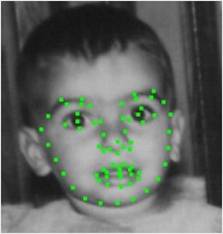
Project Milestone
Face Betrays Your Age
Yongfu Lou, Yanan Li and Xin Wang
Task Review
Even though relatively limited
efforts have been made towards it, age estimation has a large variety of
applications ranging from access control, human machine interaction, person
identification and data mining and organization.
Human face is the most essential
reflection of age. During the process of aging, changes of face shape and
texture will take place.
This project is about
estimating human age based on face images. It was splitted into four stages: dataset
obtaining and preprocessing, shape and texture feature extraction, model
training and age prediction and comparing prediction errors of deferent models.
By milestone, all these four stages
have been accomplished, while there are still several future works planed to be
done to optimize the model and minimize the prediction error. These works are
stated at the end of this paperwork.
Dataset
The database we are used is FG-NET(Face and Gesture
Recognition Research Network), which is built by the group of European Union
project FG-NET who work on face and gesture recognition. This dataset contains
1002 images of 82 subjects whose age varies from 0 to 69. Each image was
manually annotated with 68 landmark points located on the face. And for each
image, the corresponding points file is available. The figure below shows the
sample images and the landmarks on a face image.

Figure 1. A sample from FG-NET with Landmarks
Stage 1: Data
Preprocessing
Step
To simplify the processing and enhance the prediction accuracy by the end, we
chose only the images in which people faced the camera directly. Images like
Figure 2 were not used. At last, we got 617 satisfying images out of the total
1002 images in the dataset.
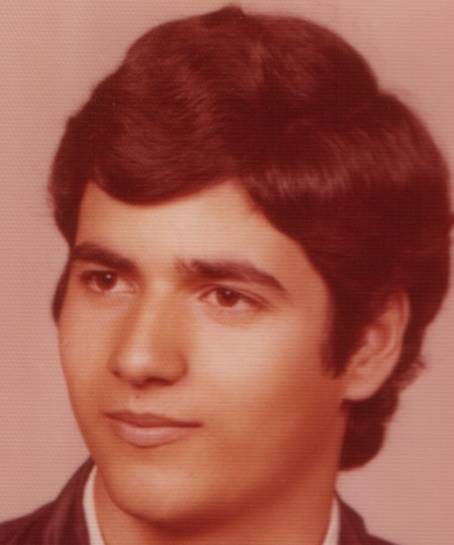
Figure 2. An image sample not been used
Step II. Image Graying.
Since we need to use the texture on the face as one important feature that
predicts the age, we processed all the images into gray scale ones; this is
shown in Figure 3.
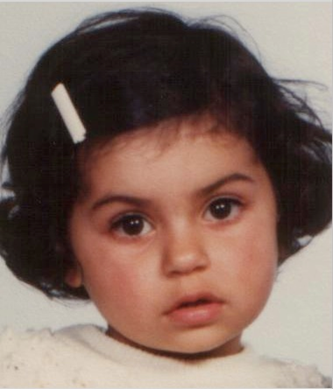
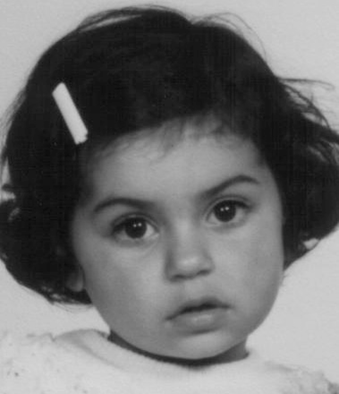
![]()
Figure 3. Image Graying
Step III. Image Rotation.
Each image was rotated until the two eyes reached horizontal; this is shown in
Figure 4.

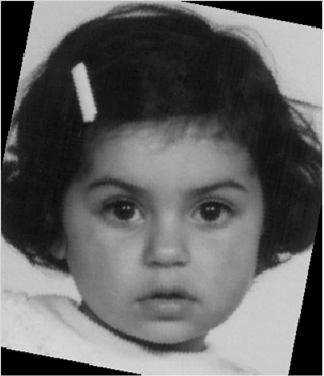
![]()
Figure 4. Image Rotation
Step IV. Image Resizing.
Firstly, go through all the coordinates files to find the shortest distance D between two eyes in each image. Then resize
all the images until the eye-distance in each image is equal to D.
Stage 2: Feature Extraction
ASM
Active Shape Model is a statistical model-based image search method, which is modeling through the statistics of the same type of the target object images. The main characteristic of ASM is to apply a statistical method to model on a certain category of target images, limiting the feature search results within the range of variation of the model by introducing the prior knowledge of the target object.
ASM is a two-step process, the first step is training model based on the training data. The second step is to take the advantage of the guidance of the training model to search image to get the object shape information. In our project, both the training data and test data are from a data set of correctly annotated images. The 68 landmarks are placed on the same way on each of a training set and it is done manually. The points can represent the boundary, internal features, etc. So we only implemented the first step. By examining the statistics of the positions of the labeled points a “Point Distribution Model” is derived. And we neglect the second step for now. The “Point Distribution Model” gives us the mean positions of the points and a number of parameters (eigenvalues) which control the main modes of variation found in the dataset.
There are three main steps in modeling the data.
1. Choosing the proper contour points.
The data set after the data preprocessing stage has 617 sample images of face and each image is annotated with 68 points on the face.
So we get a matrix named Training Data which contains the coordinate of the points and image information.
2. Aligning the data.
Before PCA is applied, we aligned the vectors a little further by moving the center of the face to a certain position in each image.
After that, we get the new shape vectors:
![]()
3. Principle Components Analysis
PCA is
applied to the shape vector by computing the mean shape:
![]()
And the
covariance,
![]()
The
eigenvalues and eigenvectors of the covariance matrix,![]() represents for the eigenvalues, and
represents for the eigenvalues, and![]() is listed in descending order.
is listed in descending order.
![]()
Choose the
t largest eigenvalues which can explain the 98% of the variance in the training
shapes.
![]()
So we can
get
![]() , and the corresponding eigenvectors,
, and the corresponding eigenvectors,![]() .
.
After PCA,
each shape vector ![]() can be written as a linear combination of
can be written as a linear combination of![]() and
and![]() :
:
![]()
In the
above formula,![]() , which are the shape parameters and the coefficients of the
first t models.
, which are the shape parameters and the coefficients of the
first t models.
AAM
To
establish the statistical texture model for reflecting the global texture
variation of the faces, Firstly, what we need to do is getting all the pixel
grayscale values in the face contour area, which can be regard as extracting the
shape-independent texture. And then we use the principle component analysis of
the shape-independent texture to modeling.
1.
Texture normalization.
We need to
get the grey value of each pixel in the texture image in a fixed sequence to
generate a vector![]() where n is the number of
the pixels. To compensate for the illumination, we need to do the texture
normalization processing. The so-called normalization is to generate gray vector
of zero mean and 1 variance.
where n is the number of
the pixels. To compensate for the illumination, we need to do the texture
normalization processing. The so-called normalization is to generate gray vector
of zero mean and 1 variance.
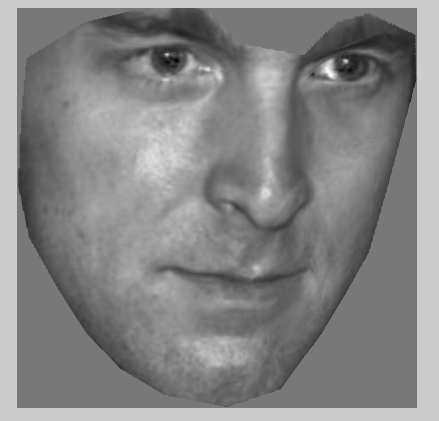
Figure
5. Example result for texture normalization
2.
Triangulation of the mean shape in shape model.
We
introduced Delaunay Triangulation method to divide the mean shape into a
collection of triangles.We
introduced Delaunay Triangulation method to divide the mean shape into a
collection of triangles.
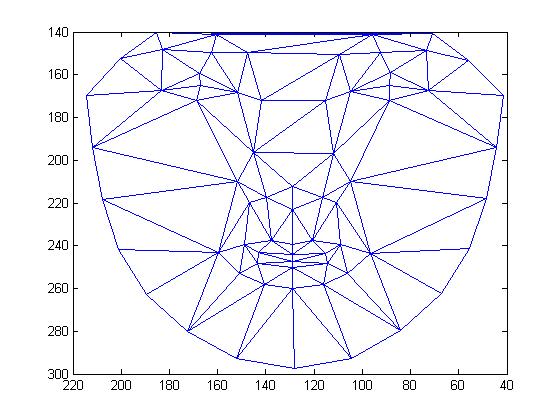
Figure 6. Result for triangulation of the mean shape
3. Obtaining the shape-independent texture.
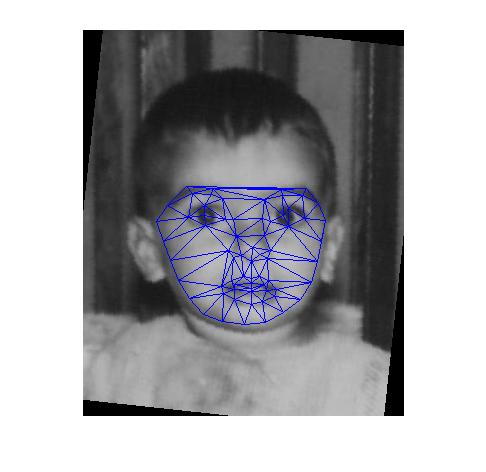
Figure7. Result for triangulation of face sample
Firstly, each face in the training set is deformed into mean shape units each triangle. After triangulation, each face image is composed of a collection of triangular mesh, therefore, by deformation of the shape of each triangle the deformation of whole face image to the mean shape model can be achieved. And by this way, the appearance sample can be obtained in the normal form of mean shape model. Therefore, we can get the shape-independent texture feature.
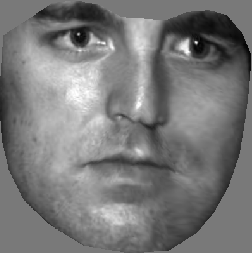
Figure8. Example result for deformation to mean shape
4. Principle Components Analysis.
Like the ASM, AAM also use principle component analysis to build a statistical model of texture. As a result, we can get the eigenvalue, eigenvectors and the mean texture of the appearance model, and after PCA, each shape vector can be written as a linear combination of mean texture and the eigenvectors.
Combination of ASM and AAM
For AAM’s original shape positioning algorithm is not precise enough, ASM cannot take advantage of the texture information, we use a combination of ASM and AAM. After obtaining the shape model and appearance model, each image can be described by a set of texture parameters and shape parameters, because AAM is built based on the shape model, so there is correlation between shape parameters and texture parameters. So it is not proper to combine the models directly, so we combine the two sets of parameters by a weight matrix.
Finally, PCA is used to extract the age feature from the combined model.
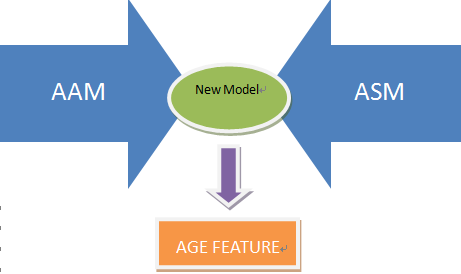
Figure 9. The combination of AAM and ASM

(a) (b) (c)
Figure 10. Comparison of original texture with the texture made by combined model.
(a) Original texture. (b) Texture made by the combined model. (c) Difference between original texture and texture described by the combined model.
Stage 3: Training Models and Prediction
Model I.
SVR (Support Vector Regression)
Specifically, epsilon-SVR, one kind of SVR, is used to predict the age of a
person from one’s face image.
Epsilon-SVR
It introduces parameter epsilon to measure the
cost of the errors on the training points. It sets epsilon intensive band to
ignore the error of all points that are inside the band.
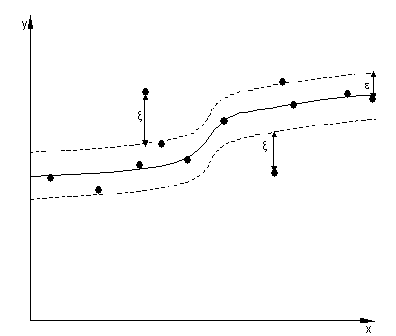
Figure 11. Non-linear epsilon-SVR
Model II.
SVC (Support Vector Classification)
 In
C-SVC, C stands for the parameter in this formula:
In
C-SVC, C stands for the parameter in this formula:
At this moment, this is no more than the normal SVM classification method. And
it will be optimized for this problem in our future work.
After converting the label to classes index, C-SVC is used to estimate the age
range of a person from a face image. The age ranges are 0-5, 5-10, 10-15, ...
,65-70 for the 5-year-a-class model and 0-10, 10-20, 20-30, ... ,60-70 for
10-year-a-class.
Stage 4 Comparing Prediction Errors of Deferent Models
Results:
result for epsilon-SVR
|
indicator |
result |
|
iteration |
203 |
|
nu |
0.792000 |
|
obj |
-404.595448 |
|
rho |
-14.999804 |
|
nSV |
396 |
|
nBSV |
396 |
|
Squared correlation coefficient |
0.0710749 |
|
Mean squared error |
121.736 |
|
Standard Error |
8.8885 (years) |
result for C-SVC
|
indicator |
5-year-a-class |
10-year-a-class |
|
iteration |
16 |
20 |
|
nu |
0.266667 |
0.700000 |
|
obj |
-3.982239 |
-13.909430 |
|
rho |
0.997459 |
0.989280 |
|
nSV |
14 |
17 |
|
nBSV |
2 |
7 |
|
Total nSV |
500 |
500 |
|
Accuracy
|
29.9145% (35/117) |
33.3333% (39/117) |
|
Average Misclassification Error |
1.4359 |
0.8462 |
To implement C-SVC and epsilon-SVR, the SVM functions Library libsvm[10]is referenced"
Analysis.
Why is the result of SVR in a sense quite acceptable while SVC performed poorly
in this problem? Can we find another way?
The reason is that SVC treats all misclassifications equally while it should
not. Apparently, one person of age 12 is more costly to be predicted to be in
class 80-90 than in 0-10. Therefore, we plan to add a misclassification error
factor to SVC to see if it will enhance the performance of the model and how
much is the improvement if exists.
Another way to improve the prediction of SVC is dividing the classification
process into 2 parts. The first one tells whether the face belongs to a youth or
an adult. In the second phrase, the system will use SVC with different
parameters to determine the specific age range.
Future work
1.Cost-Sensitive SVC (as showed at the end of the comparison of SVC and SVR)
2. Two phrases classification (as showed at the end of the comparison of SVC and
SVR)
3. Using n-fold or leave-one-out to choose the best values of the parameters for
SVR to obtain lower mean square error.
4. If time permits, we will use Matlab to make an GUI application. The expected
result is after inputting a picture without any feature points marked, the
program can tell the person’s estimated age.
[1]Xin Geng, Zhi-Hua Zhou, Kate Smith-Miles (2007). Automatic Age Estimation
Based on Facial Aging Patterns. Pattern Analysis Machine Intelligence, 29(12),
2234-2240.
[2]Unsang Park, Yiying Tong, Anil K.Jain (2010). Age-Ivariant Face Recognition.
Pattern Analysis and Machine Intelligence, 32(5), 947-954.
[3]Ramanathan, N., Chellappa, R., & Biswas, S. (2009). Age progression in human
faces: A survey. Visual Languages and Computing.
[4]Steiner, M. Facial Image-based Age Estimation.
[5]Xing Gao. Research on Facial Image Age Estimation.
[6]Hsu, C. W., Chang, C. C., & Lin, C. J. (2009). A practical guide to support
vector classification, 2003. Paper available at http://www. csie. ntu. edu.
tw/~cjlin/papers/guide/guide. pdf.
[7]Van Ginneken, B., Frangi, A. F., Staal, J. J., ter Haar Romeny, B. M., & Viergever, M. A. (2002). Active shape model segmentation with optimal features. Medical Imaging, IEEE Transactions on, 21(8), 924-933.
[8]Cootes, T. F., Taylor, C. J., Cooper, D. H., & Graham, J. (1995). Active shape models-their training and application. Computer vision and image understanding, 61(1), 38-59.
[9]Cootes, T. F., Edwards, G. J., & Taylor, C. J. (2001). Active appearance
models. Pattern Analysis and Machine Intelligence, IEEE Transactions on, 23(6),
681-685.